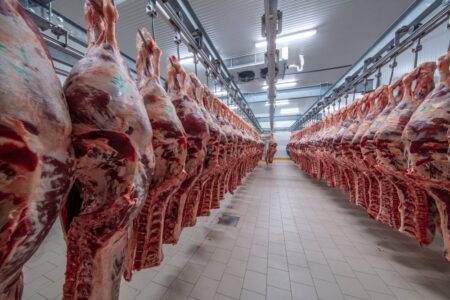Editor’s Note: This is the second in a series of four articles highlighting the contributions farmers and their tractors made to winning World Wars I and II. This story first appeared in Ageless Iron Almanac.
The shell-pocked muddy morass of World War I’s battlefields offered the ultimate performance test for a pioneering tractor originally designed to traverse the soft peat soils of California farms.
Holt’s massive model 75 crawler proved so effective at pulling large artillery pieces and supply wagons across the war-wrecked landscape of Europe’s Western Front that over 3,000 Caterpillars would eventually see use during the Wars To End All Wars. And an innovative lieutenant colonel in the British Army seeking a machine that could be used as an attack vehicle considered the Holt crawler’s success as a tractor and, thus, envisioned the first tank.
Concept Returns Home
The employment of Caterpillars by the British was, in a way, the return of the crawler concept to its motherland. One of the first successful crawler track designs was patented by Hornsby, a British company. That firm demonstrated its concept to the British Army in the early 1900s. The military was so impressed that it gave Hornsby a prize for the concept.
Crawler Created Here
The British military failed to do anything with the concept, however. So Hornsby sold the patent for its track system to Holt Tractor.
The British may have been first at creating the concept of tracks, but it took U.S. ingenuity to make the crawler tractor a reality.
That was Benjamin Holt’s genius. His brainchild was the tiller (single front steering) wheeled Caterpillar, which found ready use in Western fields and timberland.
Holt was constantly seeking new markets for his Caterpillars. Not long after the start of World War I in 1914, engineers with the then largest crawler tractor in Holt’s arsenal, the model 75, were sent to England to demonstrate it to the British Army as a tow vehicle.
Shortly after that display, British as well as French and Russian armies started placing orders for the 75s.
In time, over 1,200 of these crawlers would be shipped overseas. The U.S. War Department, alerted to the British use of the Holt crawler, placed an order for a number of Holt 75 tractors or its equal in 1916. In response, Holt developed the armored Artillery Tractor 5-ton model in 1917, although it wasn’t ready for another year. Satisfied with that design, the U.S. Army purchased 3,000 or more of these crawlers for the war effort.
The British, needing an even larger tow vehicle than the model 75 to haul their larger guns, asked Holt and his engineers to come up with an extra heavy-duty artillery tractor.
Thus, the massive 70 hp. Holt model 120 was created in 1918. Nearly 700 model 120s would be built, most of which saw action in the war.
Tank Concept Created
The capability of the Holt crawlers to readily lumber through mud and across shell holes or trenches caught the eye of a British officer during Christmas 1914.
Colonel Ernest Swinton imagined the possibility of creating an armored vehicle, equipped with guns, running on Caterpillar tracks. This machine would be able to negotiate the rough battlefield terrain and run over barbed wire entanglements (so common and effective at this time in the war) while being impervious to machine gun bullets.
Convinced of his concept, Colonel Swinton promoted the idea of an armored land cruiser to the British war office. The design caught the eye of Winston Churchill, who was then First Lord of the Admiralty, the equivalent of the current U.S. Secretary of Defense.
Tank Reverse-Engineered
Turnabout is fair play, at least when it comes to engineering. After World War I, the huge popularity of the tank inspired a tank engineer in 1919 to fashion a farm tractor that ran entirely on tracks. That engineer, Philip Johnson, created the machine for John Fowler and Company, one of the largest manufacturers of steam traction engines in England at this time.
Not surprisingly, Johnson’s innovation, which was dubbed the Snaketrac, was powered by a Fowler steam engine. Fowler went on to promote the Snaketrac, eventually offering it with an internal combustion engine. That tractor never caught on, however, and eventually was shelved.
Yet, the development of the Snaketrac led Johnson to innovate a suspension system using wire rope and springs with laterally flexible tracks that curved as a tank went around corners. Later, aspects of that track system found use in the development of high-speed tanks.
Churchill Buys In
Churchill was desperately seeking a means to break the stalemate created by trench warfare during the war. He was sure Colonel Swinton’s concept had merit and, in turn, convinced then British Prime Minster Lloyd George to back development of the tank.
The first concept vehicle employed crawler tracks that ran up and over the vehicle on either side of its structure.
Two 6-pound guns were mounted in sponsons, or turrets, jutting from the sides of this new-fangled vehicle.
Following a successful trial of what was then being called a “tank vehicle” in February 1916, the British military ordered 100 of the vehicles for use on the Western Front in France. That number quickly grew to hundreds.
The advent of the tank helped turn the tide of the war for the Allies while greatly altering how wars would be fought in the future, and it all started with a common farm tractor.


:max_bytes(150000):strip_icc()/storms-shelf-cloud-58b73f323df78c060e17c9b4.jpg)




:max_bytes(150000):strip_icc()/holtcrawler-100149318-86ad21e675a143c58aaa75694f00b259.jpg)



:max_bytes(150000):strip_icc()/Visual_Search_Campaign_Background_Optum_300_Hood_320514_10-21_Clip_CIH_Social-651778ed95f54af0b1cf65e29e4f8cbf.png)
:max_bytes(150000):strip_icc()/Markets-6-Drought-down-8-f8274ff80cbe4cc9bfa86411ddbd9cf0.jpeg)